TAIWAN BEEF NOODLE SOUP / NIU ROU MIAN
(简体)(繁體) UPDATES AVAILABLE * 2013/03/11: online sources for ingredients added!
I’m gonna start this by saying something that seems completely irrelevant… The Japanese are marketing geniuses. No, not geniuses. Gurus! No no, NOT gurus. GODS!!! It’s like their entire way of life comes with a built-in marketing system that in comparison would reduce Don Draper down to nothing but just a raging alcoholic. I mean really, something about their culture is so mesmerizing that… OH look! Hello Kitty! (slap! FOCUS!) …that they’ve become easily one of the biggest culture exporters in the world, and most evidently in their success in pushing their cuisine into a world domination that’s stronger than the force of nature. Not so long ago who would’ve thought that Americans, the genetically-hardwired loyal patrons of well-done white meat chicken, would pay $200 and UP to surrender their fork’n knife, pick up the chopsticks (some awkwardly) and chew down a piece of raw fish on vinegary rice then moan, “Mmmmm… UMAAAAMI…”. Seriously!! Forget X-men, THIS is where human mutation takes a giant leap!
I’m telling you, it’s crazy. Japanese can sell anything like it has a halo on top of it.
I know you’re thinking, “There better be a point in this because THAT picture looks nothing like ramen…”. There. My point’s exactly. Ramen. The Japanese bowl of noodles that has taken New York (then the rest of America) by the storm starting a few years ago. It’s about the most highly regarded bowl of noodle soup out there, $15 high. Think Vietnamese Pho Bo – a dim and smudgy joint tucked in the corner of Chinatown somewhere. Think ramen – wooooh zen-like environment, streamlined dark-wood counter with a super serious chef behind it who looks like he whispers to his knives and noodles. It even inspired a movie called “The Ramen Girl”. It’s just noodles man! Damn it! They’re good!
Yeah, back to there’s a point in here somewhere. Point is I’m saying this out of the deepest admiration for their craft, but the most mind-boggling frustration for our own. Because not just the Japanese, when it comes to noodles, everyone else seems to be getting a bit of the spotlight but us.
I was born in this little island named, I don’t know if you’ve heard, Taiwan (beaches?… no that’s Thailand…). The Japanese were there for awhile you know – 50 years! One would’ve thought that we had picked up a trick or two on how to make ourselves look cool. But no! Taiwanese are stubborn and proud blood who likes everything wrapped up in red-stripes plastic bags, then eat it under fluorescent light. I just don’t get it. We deserve some buzz, too and all we lack is some serious packaging. You know that little pork bun that David Chung is getting all the credits for? That’s actually us. And the worldwide phenomenon, the bubble tea? Us again. Yeah, we don’t say.
But perhaps Taiwan’s will to shine isn’t completely flaccid yet. At least staring in the face of ramen’s raging success still aroused a bit emptiness inside…
So in the wake of a gradually apparent international irrelevance and the effort to resuscitate the dying will of even-trying, a few years back the government initiated a regional contest of our very own national noodle soup. Niu rou Mien (It translates into beef noodle. If it doesn’t sound cool it’s because it’s not in Japanese… try “nyoru men”). It successfully injected a new-found enthusiasm and energy into this almost old-school dish across the country (don’t get too excited because the buzz is still very well contained ONLY within the country) that all of a sudden niurou mien is cool again. No, more than cool. It is now a matter of national pride.
I assure you that I am no cultural ambassador or tourism promoter (yeah I’m not done yet). In fact when it comes to this kinda-like-home island, I’m meaner to it than anyone else I know. So this isn’t about nationalism. This is about giving credits where credit’s due. We’re not much (I aim to exaggerate) but we’re still something. And I’m going to put this little post out there (did I mention I so happen to make a very mean niurou mien?). And hopes that someday, someone would stumble into this little microscopic blog. A someone who’s much better than me at making stuff look super cool, who happens to be looking for the next super big noodle idea, and coincidentally knows a somebody else who has $500k disposable cash to invest in a small-yet-super-trendy restaurant in New York that charges you $15 for a bowl. And when ALL THAT finally… and super miraculously happened, people would start saying, “Man, Taiwan’s niurou mien is super AWESOME!”.
Serving: 6 ~ 7. Updated on 2012/10/15: recipe for sauteed pickled cabbage below.
* The recipe calls for a very deep and rich stock as the base/foundation of the soup. This is why I published the golden foundation post right before this one. The components in this stock would vary a little bit, but the technique is completely the same. If you have homemade, UNSALTED stock at home already and aim for a quicker recipe, you could just use what you have on hand already but the flavor may be less intense.
** This dish is usually prepared in 2 parts. There’s the pot of braised beef that should be salty and intense, and the unsalted stock that’s reserved to dilute it later when ready to serve.
Stock: You would need a total of 10 ~ 11 cups of stock. Details on how to make the stock/broth, please go here.
- 2 large beef shank bones (cut into pieces), or 5~6 pieces of rib bones
- 1 chicken scaffolds, or 1/2 a free range chicken
- 1 pig’s trotter (cut into 4 pieces)
- Aromatics
- 1 medium onion
- 1 small carrot
- 2 jumbo scallions
- 5 slices of ginger
- 5 cloves of garlic
- 3 star anice
- 1/2 of cinnamon stick
- 1 tbsp of black peppercorns
- 1/2 tsp of fennel seeds
- 1/2 tsp of cumin seeds
Make the stock according to the instructions in the previous post *. It would take several hours but it can be made days ahead of time.
Niurou Mien Ingredients: (I warn you it’s quite long…) *Posharp Store is a good sourcing option for Chinese ingredients.
- 1000 g of beef riblets meat, or boneless shortribs
- 400 g of jumbo scallions, cut into sections
- 60 g of ginger, cut into slices
- 1 head of garlic, smashed
- 1 large onion
- 1 tomato
- 2 tsp of rock sugar, or raw sugar
- 4 dried chili (optional if spicy is not your thing)
- 2 packs of Chinese aromatic herbs packet, or assemble a simple one of your own
- 6~7 star anise (depending on the size)
- 1 cinnamon stick
- 4 dry bay leaves
- 1 1/2 tbsp of fennel seeds
- 1 tbsp of cumin seeds
- 2 tbsp of whole Sichuan peppercorn
- 1 1/2 tsp of ground Sichuan peppercorn (for extra kick and “numbness”)
- 1 tsp of ground coriander
- 1/4 tsp of five spice powder
- 1/4 tsp of black pepper
- Paste mix
- 6 tbsp of tomato paste
- 6 tbsp of douban paste (Chili bean paste. Can be purchased here or from major Asian markets)
- 1 tbsp + 1 tsp of shacha paste (Chinese BBQ sauce. Can also be found on Amazon)
- 1/3 tsp of curry powder
- Seasonings
- 1 cup of rice wine, or sake
- 1 cup of soy sauce + 1/3 ~ 1/4 cup for adjusting (Every brand of soy sauce has different saltiness. Avoid soy sauce that’s on the “sweet” side, for ex Japanese brands)
- 2 tsp of rock sugar, or raw sugar
- Stock: 6 cups of stock/broth * (reserve the rest for later)
- To finish
- 1 tsp of rice vinegar
- 1 1/2 tbsp of unsweetened, or VERY LIGHTLY sweetened peanut butter (this is a bit weird but I really believe it adds to the depth of the flavor). Don’t use Jippy.
- 5 ~ 6 cups of reserved stock/broth
- Garnish
- Finely diced baby spring onion
- Chinese pickled cabbage (more notes on that in the next post)
2:00 ~ 2:30 pm: Dice the beef into 2″ x 2″ (5 x 5 cm) cubes, and divide them into 2 batches (for easy browning). Heat up a dutch oven or in my case, a wok on medium-high heat. Add 2 tbsp of oil, 1 batch of beef cubes and 1 tsp of raw sugar. Flip them occasionally and let the beef and sugar brown and caramelize on all sides. Take the first batch out onto a plate, and repeat the same step with the second batch until all browned as well. Then take all the beef cubes out and set aside.
2:30 ~ 2:40 pm: Add 3 tbsp of oil into the same pot, and add the jumbo scallions, ginger and 1 tsp of raw sugar. Leave them toasting in the pot on medium-high heat until they become very caramelized (almost seem a bit burnt). During this time, cut the onion in half and toast them over open fire on the stove until charred, then set a side. Once the scallions and gingers are caramelized, add the onion and garlics. Saute for a couple minutes more.
2:40 ~ 2:50 pm: Add the paste mix and saute until fragrant and the paste has darken in color, approx 2~3 min. Add the aromatic herbs now if you are assembling your own (add them later if you are using store-bought packets). Saute for another couple of minutes, then transfer EVERYTHING including the beef cubes into a pressure cooker or a large stock pot (or if you started with a big enough dutch oven then just stay with it). If there’s brown bits on the bottom of the pot, deglaze with 1/4 cup of water and add to the pot as well.
2:50 ~ 3:00 pm: Add the seasonings and let it boil for a couple of seconds, then add 5 1/2 cup of stock (add the store-bought herbs packets now if that’s what you are using). UPDATES 2013/05/08: oops I forgot but you should add the tomato (cut in half) at this point. It is now crucial to taste-test the seasonings. Different brands of soy sauce differs in saltiness and sweetness, so much that it is impossible to standardize by saying “however-many-cups of soy sauce”. I would STRONGLY recommend using a LESS sweet version of soy sauce (you can see the one I’m using from the picture). Taste the soup now. It should be fairly salty (too salty to drink as a soup) with a SLIGHTEST (almost untraceable) hint of sweetness just to balance it off. If the saltiness seems too “sharp” and unrefined, add more rock sugar. If it’s a bit too bland (in this case “drinkable” as a soup), add more soy sauce. I ended up adding 1/8 cup more of soy sauce to my pot (but with a less salty brand of soy sauce, it could be more).
3:00 ~ 4:00 pm (or 5:30 pm without pressure cooker): Put the pressure cooker lid on and bring to a “hiss” on high heat, then turn it down to medium-low and cook for 1 hour (reduce the cooking time to 45 min if using shortribs). If you are doing it on the stove-top, simmer for 2~2:30 hours.
4: 20 ~ 4:50 pm (or 5:30 ~ 6:00 pm): Open the lid once the pressure’s completely release and check the done-ness of the beef. If they are still tough, keep cooking (lid on) for another 30 min. Prepare another large pot and rest a sieve on top of the pot. Strain everything through the sieve into another pot. Carefully pick out the beef cubes without breaking them, then use a wooden spoon to press VERY HARD on the scraps to extract every drop of juice left in them. You’d be surprise how much it is. Discard the scraps. Return the beef cubes back into the soup and add 1 tsp of rice vinegar, then dissolve the unsweetened peanut butter into the pot (or through a strainer if the peanut butter is chunky). UPDATES: 2013/06/24: I find that an extra 1 tbsp of uncooked tomato paste, dissolved in the end, adds a good layer of depth.
There. We are done.
To serve it, cook your favorite noodles (I like the fat ones) and dilute the soup with 1 : 1/2 as the ratio of braised beef soup: unsalted stock. So with 1 cup of braised beef soup, add 1/2 cup of unsalted stock. This would still yield a slightly salty soup but that’s how I like it. Or you could simply use the braised beef soup only as a sauce in the “dry noodle” version.
MUST ADD spring onions and pickled cabbage. That’s not even negotiable.
Saute Chinese Pickled Cabbage:
-
430 g of pickled Chinese cabbage (“Suan-cai”. An olive-green pickled cabbage that’s usually vacuum-packed, and is sold at major Asian markets)
-
6 dried chili
-
2 tbsp of sake
-
2 tsp of sugar
-
3 tsp of rice vinegar, or white wine vinegar
-
1 1/2 tbsp of Dijon mustard
-
Pinch of white pepper
- 5 tbsp of oil
- 1 tbsp of sesame oil
Rinse the cabbage clean and squeeze dry. Remove the tough fibers at the head of the cabbage, then separate the stalks and the leaves. Finely chop or slice the stalks and soak in water for 4~5 min. Then chop the leaves finely and add to the stems (which has been soaking for 5 min), and soak for another 2 min. Take the cabbage out of the water and squeeze it completely dry.
Heat up the oil plus the sesame oil in a wok or skillet, toast the dried chili in the oil until the color has darken. Add the cabbage, sake, sugar, rice vinegar and Dijon mustard and stir frequently until the moisture from the cabbage has mostly evaporated, and the volume has shrunken down to almost 1/2. This will take several minutes. Finish by dusting with a pinch of white pepper.
This should keep in the fridge for up to 3 weeks.


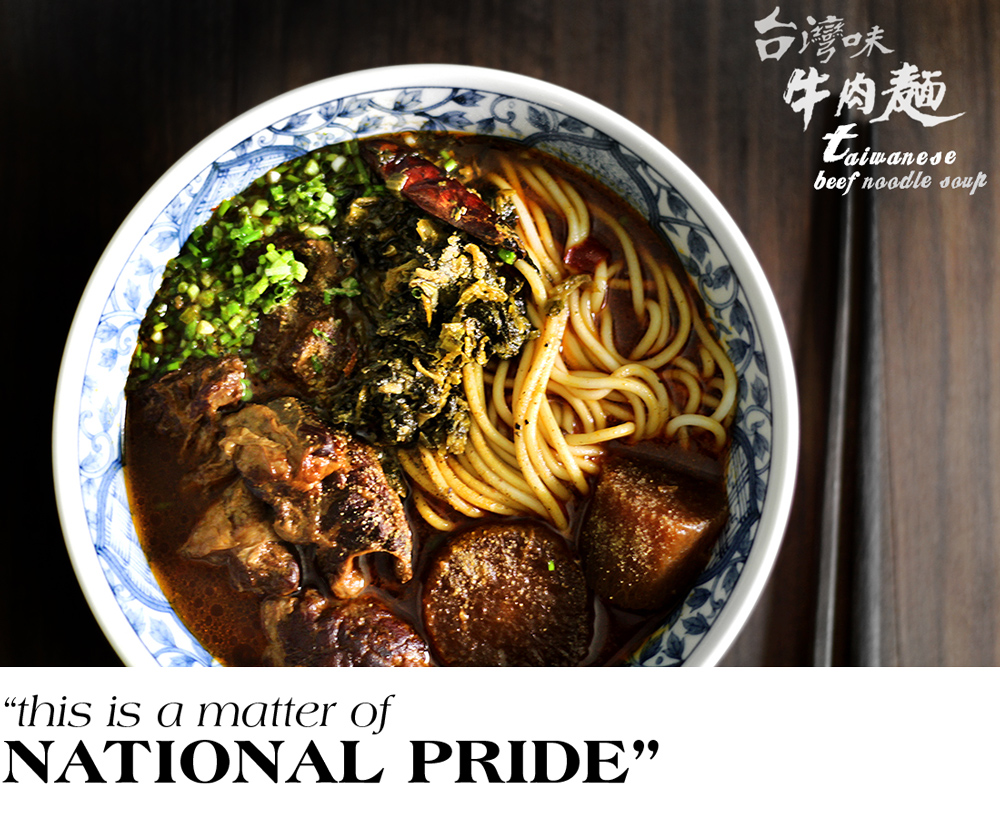
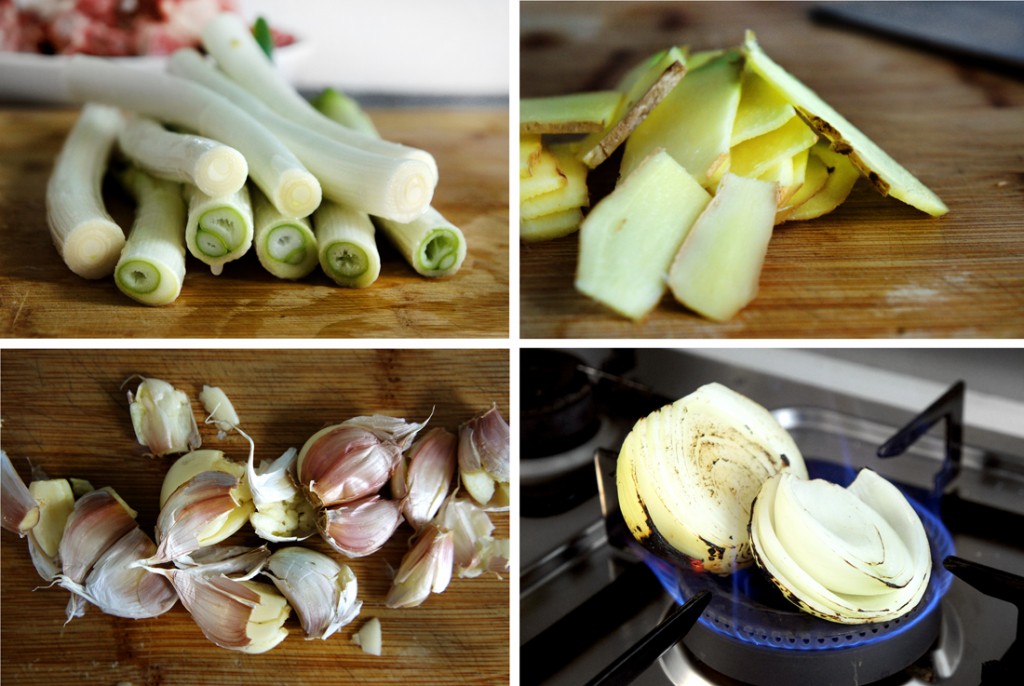




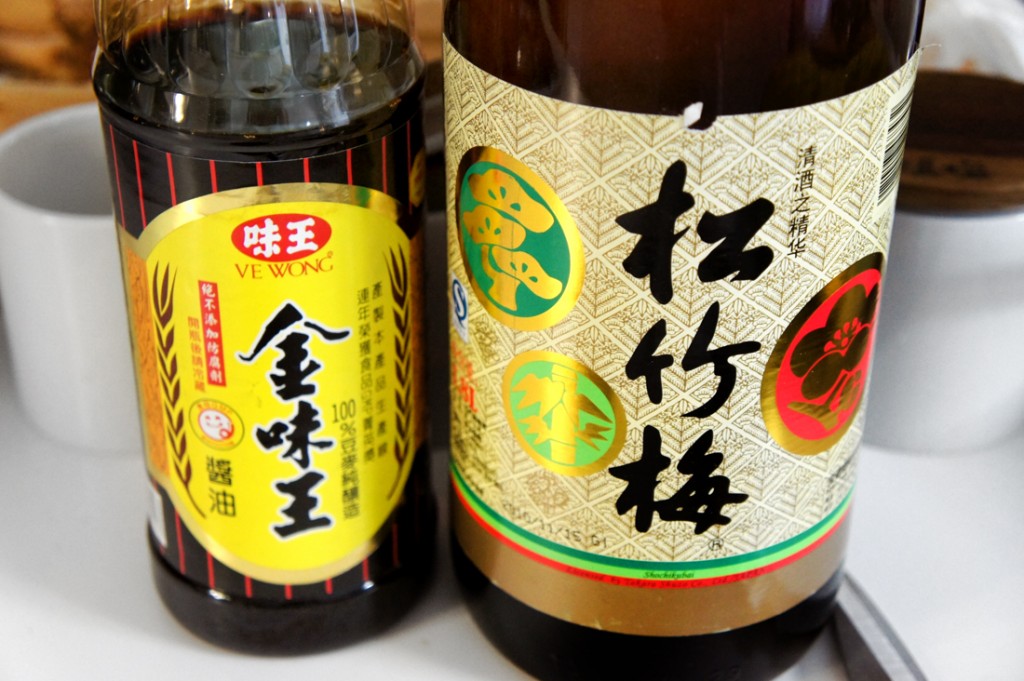
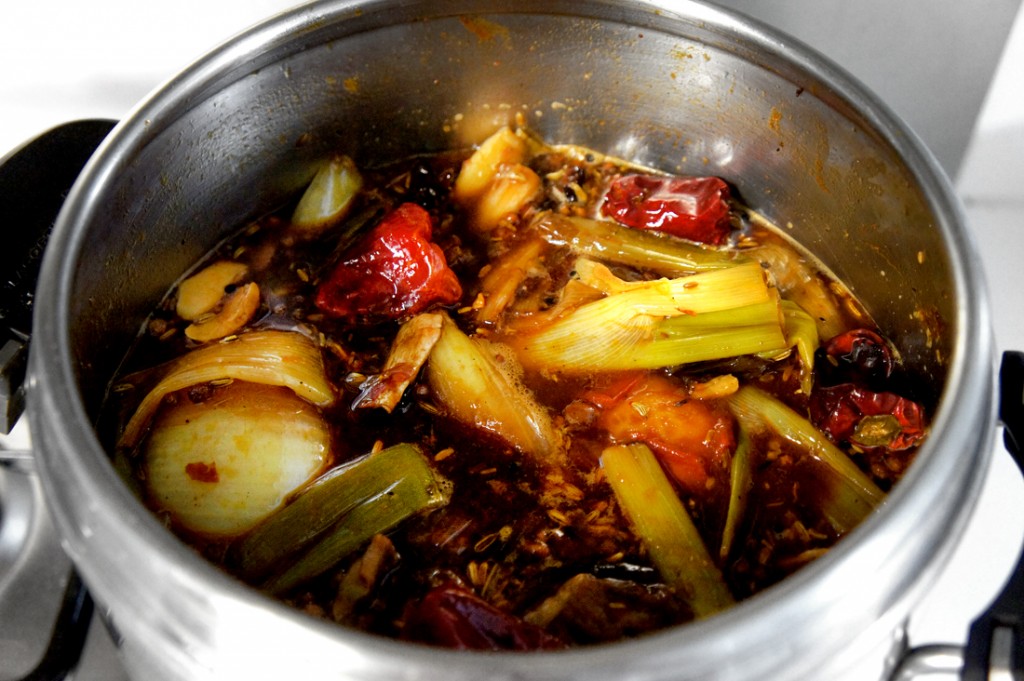
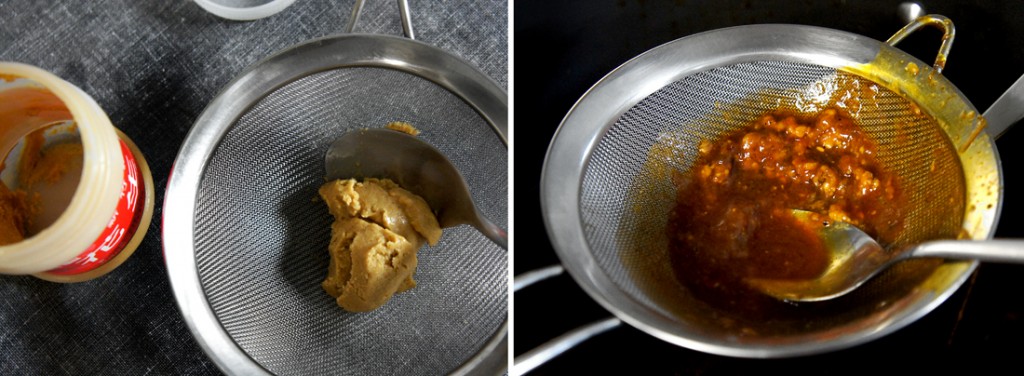
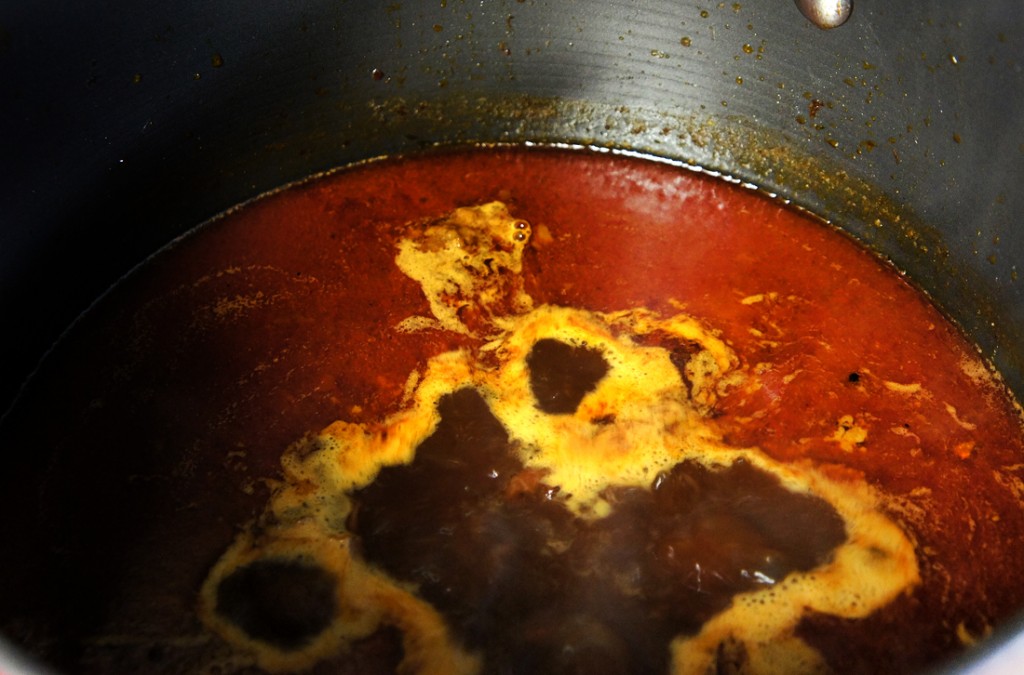


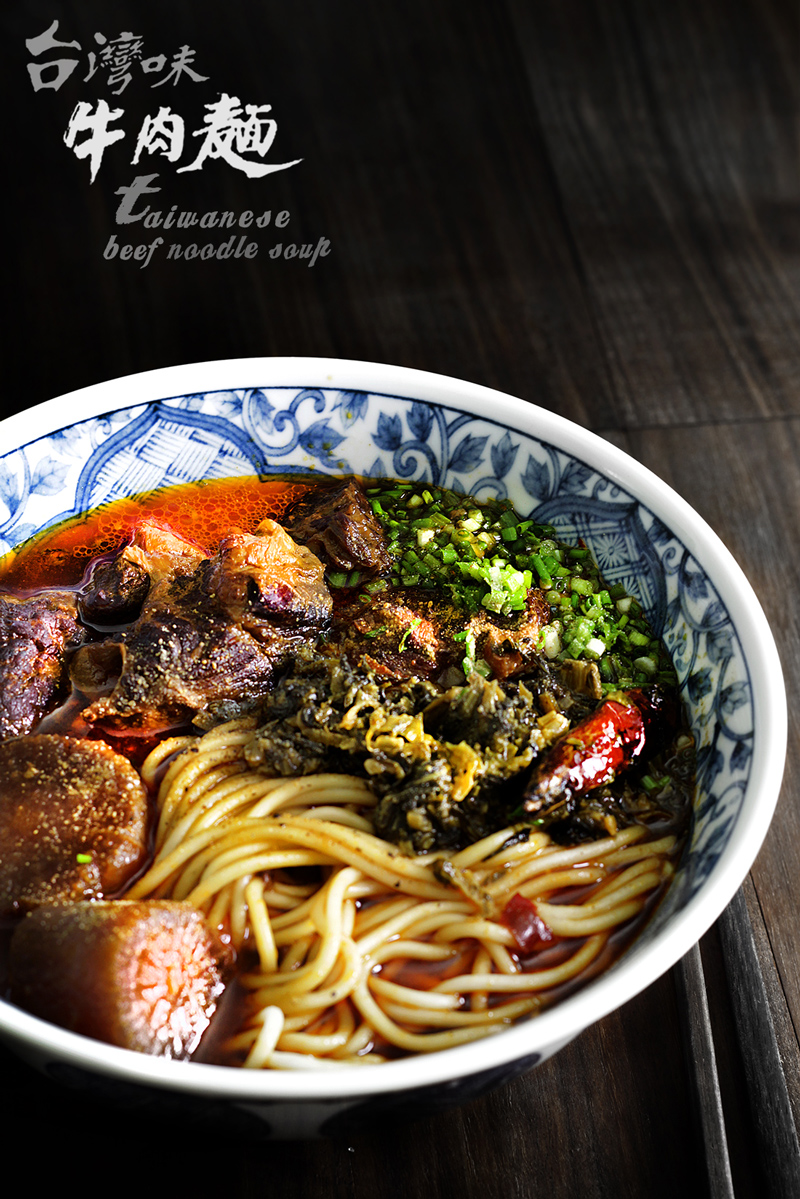
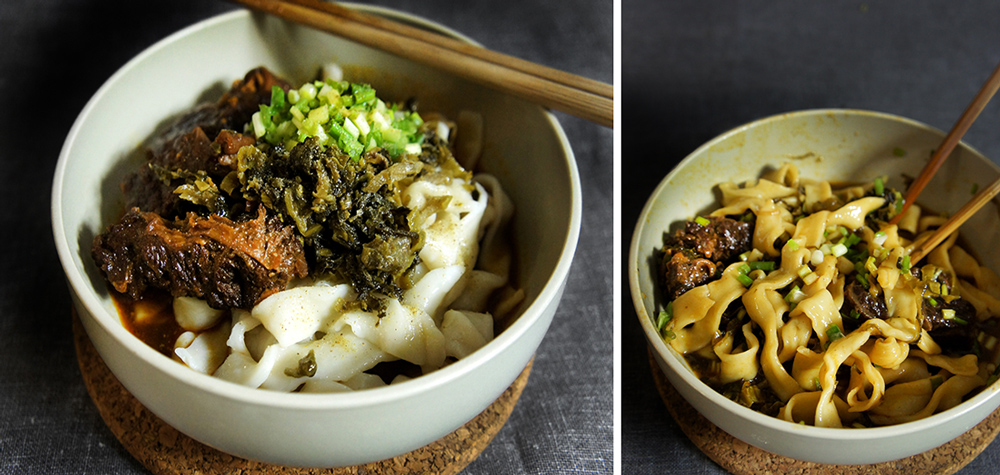

Tracy
09.29.2012at8:23 AMHi Mandy,
I wanted to complement you on the excellent job you’ve done with this blog. I find your comments and directions incredibly informative. I especially love your Taiwanese dishes. I was born in Taipei, but have lived in US almost all my life (LA, SF, NYC). I love Taiwanese food but have not come across many great recipes. Your Niu Rou Mien recipe is the best I’ve found, and I also look forward to trying the other asian dishes that you’ve featured on this blog. Keep up your awesome work, and I look forward to coming back to this website frequently!
Mandy L.
09.29.2012at2:16 PMTracy, thanks so much! That means a lot and I will keep it up!
Amy Wu
09.05.2014at10:08 AMHey Mandy! I loved this recipe last time and want to make it again. Do you think I can use store bought stock? If so, any recommendation on what kind? Thanks!
Amy
Julia @ JuliasAlbum.com
09.29.2012at4:32 PMI love your photography. I am also excited to explore your blog because I love learning more about different cuisines.
JLo
09.30.2012at9:06 AMAwesomeness~~~ Thanks Mandy
rooth
10.09.2012at9:22 PMThis is one of my favourite dishes and it looks like you’ve made it perfectly. My dad makes this at home for me and I can’t get enough
annisa
03.11.2013at12:35 PMDecided awhile ago this looked like my dream bowl of noodles and since I live nowhere near Taiwan I need to figure this out myself. This looks awesome. I guess some restaurants add Chile oil? But yea…Ty bunches. Love from Alaska :)
Mandy L.
03.11.2013at2:36 PMAnnisa, I have added online sources for ingredients that are harder to find in grocery stores. I hope it help!! And of course you could add chili oil for heat. Check out my post for a great chili oil recipe :)
Rolandachow
03.24.2013at12:31 PMAfter drooling over your pictures of this noodle soup, I finally had a day when I had nothing but time. I made this for my picky Taiwanese husband and he was speechless! He loved it! Thank you for sharing this awesome recipe.
Mandy L.
03.24.2013at12:41 PMomg I can’t believe someone actually braved this recipe!! I’m so glad you guys liked it. It’s a great trick to freeze each portion individually (since it’s such a large portion) and when the craving strikes, INSTANT Taiwanese beef noodles!
Rolandachow
03.26.2013at5:28 AMGreat minds think alike, I actually froze the leftovers into individual portions. It does take time to make, but it’s a gift that keeps on giving.
Mmk
04.06.2013at11:17 PMHi,
I’m from Taiwan.
This blog is the most diligent one in all blogs I ever viewed.
The content is great & rich.
I never saw a blog with the Taiwanese Beef Noodle recipe so clear & in detail.
Also with the fine photos.
Just like to read a professional recipe.
Thanks for you to share this great recipe & blog.
這是目前看過最用心經營,內文最棒最豐富的中英文對照牛肉麵食譜部落格!
而且照片超精美,有種在看專業食譜書的質感。
無論如果,不推薦一下對不起自己!
台灣美食需要這種用心的人發揚!
可惜我沒50萬美金在紐約開一間牛肉麵店!
Mandy L.
04.07.2013at2:37 AMmmk,實在太感謝你這麼用心的回應!我會再接再厲!
Dave B
05.08.2013at3:08 AMI’m an American who lived in Taiwan for 27 yrs, most of it in and around Hsin Chu where they have a street that is famous for this (it used to be an alley). I’ve made it before from other on-line recipes but it was always a simpler, and consequently, lesser version. I can’t wait to make this – TOMORROW. Now we need the recipe for Dau Syau Mien.
Mandy L.
05.08.2013at3:29 AMDave, that takes some skillz! I will need time to practice ha. I hope you like this recipe.
Jake
05.08.2013at5:31 PMOK, made the stock 2 days ago and now my soup is brewing…2 hours to go.
Just wondering where the tomato (in the ingredients list) fits in?
Also, i couldnt source the “boneless” shortribs so i substituted flank at the recommendation of the asian butcher.
I couldnt find the exact sauces either (Shacha and Douban) but used “soybean and chilli paste” (looks like sambal) and a Korean BBQ marinade. Cant be that far off as the taste test (and smell) takes me straight back to Taiwan 1997/98 when i spent 8 months working and eating Niu Rou Mien every chance i had.
If i pull this off, i will be eternally gratefull. Easily the best meal on the planet…even better than tea eggs!.. which now i have cracked the code to the sauce i sometimes got on them i feel i have mastered the recipe… be nice to see how you make them (with a sauce to accompany them).
Will hopefully post the results of my Niu Rou Mien attempt #1…its looking good so far, cant wait…but it will be worth it.
TYVM
Mandy L.
05.08.2013at6:09 PMJake, wait did I not say where to put the tomato?? It should be added to the stew in the beginning.. (oops I will certainly correct that…). Flank tends to be lean and tougher and more fibrous. I personally wouldn’t think it’s a good substitute because I like fattier cuts (leaner option includes shank-meat which is very common in niu-rou-mien as well). I have never tried Korean BBQ sauce in this before so I can’t say for sure… (it would probably add a considerable sweetness to the soup). The exact brands of “douban” and “sacha” paste is included in the post as links (an online asian grocery shop). You should really try them because they are kind of irreplacable (sorry being a bit of a control freak on my niu-rou-mien which I take WAY TOO seriously BUT ONLY BECAUSE I really really want you to have the best recipe!!!!).
Oh tea eggs is definitely something I haven’t mastered yet. Will crack it at some point in my life..hahaa
pls do let me know the result!
Jake
05.25.2013at11:39 AMWell…first batch was pretty spicy as the douban alternative i used was like a chilli paste with a little bean paste. Also i use packet spices which resulted in alot more star anise than specified. Having said that it was still a very tasty recipe.
So i had 1/2 stock left from first batch and cooked up a second attempt. Having got the right sacha and a different alternative for the douban (cant seem to find it anywhere so i will have to search the net), this time i used exact spices and it turned out much better…amazing recipe. Didnt realize how much 400g of scallions was so the 100g bunch i got was not nearly enough, so i added another brown onion. Tasted even better after a couple of days in the fridge.
Definately worth the effort and cant wait to cook up the third batch. Seems like a fair amount of soup left once all the meat is gone. Is it ok to get some more beef and brown it and then slow cook in left over stock/soup?
Mandy L.
05.25.2013at1:08 PMJake, the exact DOUBAN I used can be found on the link included in the recipe: http://posharpstore.com/en-us/juancheng-pixian-broad-bean-paste-8-oz-p2768.aspx
This online store sells a lot of Asian ingredients not found else where.
Yes, LOTS OF GREEN ONION is one of the keys :)
I’m glad your second batch came out much better :) I guess you CAN add more meat to the leftover stock although i haven’t tried it before… should be fine. Let me know how it turns out if you do.
Lisa Izaguirre
08.14.2013at3:29 PMwell done
Lisa Izaguirre
08.14.2013at3:31 PMwell done It looks extremely yummy
Shirley
08.29.2013at6:18 AMOh…my…goodness! I can’t believe I have found this amazing blog! I am from Taiwan as well by the way. I thought it was just another “American version of Chinese food” when I found one of the cold noodle recipe from Foodgawker. But I was so wrong. It is so authentic…so in depth…so decent… Absolutely LOVE your photos! I am a mom who love cooking and photography. Your blog is just way beyond regular! Thank you for sharing our Taiwanese gourmet food with your talent!
你的部落格真的是太太太太太強了!真的….在foodgawker裡面找的其中的一道四川涼麵食譜,只是在想…可能是哪個美國的美食雜誌的字以為中式的美式食譜…因為那相片看起來很厲害,想應該是什麼大間的雜誌出的專門的一個食譜專欄吧!結果…看到這個台灣牛肉麵!讚!真的是National Pride as you said!
支持你!很棒!超欣賞你的部落格尤其是照片!
你隨便回台灣出個中英文對照的食譜,應該很容易打敗其他人喔!讚
Mandy L.
08.29.2013at1:30 PMshirley, 哈哈大大感謝!
vivianlicullen@yahoo.com
08.31.2013at1:38 PMDear Mandy
How can Niu rou Mien not be the national treasure with the way you make it? I am so glad I found your blog. As a proud fellow Taiwanese living in the US, I miss very authentic and tasty Niu rou Mien. I do try to make it from time to time but I never make the real Niu rou Mien like this. I am going to give it a try this long weekend and hopefully I won’t disappoint you or myself. Keep up the good work. So enjoy reading your blog.
Amy
09.12.2013at4:19 AMHi Mandy,
I am so excited to try making this recipe this weekend! I am going to assemble my own aromatic herbs packet. After I gather all the ingredients, should I find a little pouch to put it in or can the ingredients be directly put in at the specified step? Please advise.
Thanks!
Mandy L.
09.12.2013at2:59 PMAmy, the soup needs straining after it’s done anyways so I usually just put all the spices directly into the soup, but you can of course put it into a pouch if you want to. But there’s a thing in me that feels the spices would be more aromatic if they were saute/toasted in the pan with other ingredients first.
Amy Wu
09.05.2014at10:12 AMHey Mandy!
My first post ended up on another thread so I apologize for the redundancy! Anyways, I loved this recipe last time and want to make it again. Do you think I can use store bought stock? If so, any recommendation on what kind? Thanks!
Amy
mandy@ladyandpups
09.05.2014at1:44 PMHi, Yeah of course. I would recommend using a more neutral-flavoured stock without too much western herbs like thymes and rosemaries. I like this brand of stock for its flavour and versatility: http://www.amazon.com/Pacific-Natural-Foods-Low-sodiumchicken-32-Ounce/dp/B003VIFH1K/ref=sr_1_1?ie=UTF8&qid=1409895775&sr=8-1&keywords=organic+stock
mandy@ladyandpups
09.05.2014at1:46 PMOops I gave you the “chicken stock” link. You’ll want to use the beef. KEEP IN MIND that the end result will be MUCH LIGHTER than if you use a rich homemade stock. http://www.amazon.com/Pacific-Natural-Foods-Organic-32-Ounce/dp/B003VIFGZ2/ref=sr_1_5?ie=UTF8&qid=1409895775&sr=8-5&keywords=organic+stock
chutoro28
09.27.2013at4:42 AMThank you for the recipe!! I have had NRM in Taiwan a few years ago and although I live in an area with a large Taiwanese community the restaurants did not compare. I tried this recipe last night and it tasted just like the NRM I had in a small restaurant off a tiny alleyway in Taipei. This knocked the socks off my Taiwanese-American husband, who said that this NRM was better than his dad’s X_X !!
I am so grateful for an authentic NRM recipe!! Keep up the excellent work! I Look forward to trying more Taiwanese recipes!
Michael
10.24.2013at10:42 AMI’ve been searching a good beef noodle soup recipe for a long time. Your blog looks amazing by the way! At the “stock” section on this page you’ve got “•2 large beef shank bones (cut into pieces), or 5~6 pieces of rib bones •1 chicken scaffolds, or 1/2 a free range chicken •1 pig’s trotter (cut into 4 pieces) •Aromatics
“. But you also wrote “You would need a total of 10 ~ 11 cups of stock (which is the golden foundations)”. I’m a bit confused how to make the broth now. Do you need both the golden foundation plus all the ingridients under the stock section on this page? Thanks :)
Mandy L.
10.24.2013at1:14 PMMichael, sorry for not being specific. You should make the base-stock for this beef noodle soup with the ingredients listed on THIS POST. The Golden Foundation post just shows you HOW TO make the stock (the technique and process).
So, make the stock according the “Golden Foundation’s” INSTRUCTION, but WITH THE INGREDIENTS LISTED ON THIS POST. You will need 10 ~ 11 cups in total.
I hope this is more clear?
Michael
10.24.2013at2:45 PMMany thanks Mandy! I understand now :)
Angie
10.28.2013at9:09 AMThis recipe looks complex, time consuming and absolutely wonderful. That’s all good. I enjoy making an entire recipe with no help – stock, seasonings, roasting, etc. I really like your timeline too. I’m going to make this next weekend. Thanks for the post!
Joyce
10.29.2013at12:03 AMI was noticing your comment about Taiwan needed to market its amazing food more: “We deserve some buzz, too and all we lack is some serious packaging. You know that little pork bun that David Chung is getting all the credits for? That’s actually us. And the worldwide phenomenon, the bubble tea? Us again. Yeah, we don’t say.”
Given the great job you’re already doing as an ambassador, maybe you have an official future in this. “Cuisine Internationalization” is part of the “Six Key Emerging Industries” that the government is set to promote in the coming years: http://www.cepd.gov.tw/att/0015330/0015330_1.pdf. They’re looking for entrepreneurial people to take hold of this idea of promoting Taiwanese food the way it should be promoted. Take a look!
Mandy L.
10.29.2013at1:04 AMJoyce, thanks so much for the info!! It would be amazing if I could be part of this :)
Robert
01.24.2014at12:06 AMI am Taiwanese, and I’ve been itchin’ for some NIU ROU MIEN. Gonna try this when I get a chance.
Great website! Your photography really draws peeps in. Keep up the great work.
Jasmine
03.10.2014at9:32 AMOh my god, I am going to tackle this someday. Possibly soon. I feel nervous.
mandy@ladyandpups.com
03.10.2014at12:33 PMJASMINE, gonna be honest… it’s quite a project. But it’s so rewarding!! deliciously!
Joyce
03.11.2014at4:56 AMYou wrote:
“hopes that someday, someone would stumble into this little microscopic blog. A someone who’s much better than me at making stuff look super cool, who happens to be looking for the next super big noodle idea, and coincidentally knows a somebody else who has $500k disposable cash to invest in a small-yet-super-trendy restaurant in New York that charges you $15 for a bowl. And when ALL THAT finally… and super miraculously happened, people would start saying, “Man, Taiwan’s niurou mien is super AWESOME!”.”
My little contribution toward nudging people to stumble into this blog was to write it into a book for entrepreneurs in Taiwan (see link above — yay, it’s written and out now!). So, any of you globetrotting entrepreneurial readers here, I encourage you to take Mandy’s challenge seriously!
mandy@ladyandpups.com
03.11.2014at1:31 PMJOYCE, thanks so much for getting the word out!!!!
Rose
07.30.2014at2:30 AMOMG you rock!
steph
09.12.2014at3:08 PMThis is definitely the most comprehensive NRM recipe I have ever found, with the most delicious photos! What is the yummy-looking root vege in the pictures? I don’t remember reading about them in the instructions.
mandy@ladyandpups
09.12.2014at3:22 PMSteph, OH hahaa that was daikon! I didn’t put it in the recipe because it isn’t exactly “proper” beef noodle. You can add it if you are a daikon person like me :)
Liam
10.09.2014at5:07 AMHi Mandy! This is a great recipe for such a great meal. Thank you so much for posting such a comprehensive recipe.
After finding your blog just now, and flipping across some of your recipies, I am really impressed with your creativity and attention to detail. It’s given me a lot of inspiration! Please keep up the great work! :)
Pingback:Food Recipes | Food Recipes
11.10.2014at4:36 PMRenae
11.23.2014at9:43 PMThank you for sharing~ I love everything about taiwan, especially the people and the food. I’m going to try your recipes. Thanks again.
Ted
12.08.2014at5:30 AMBless you for this recipie. I want to make love to a giant bowl of this.
Frankie
01.05.2015at2:11 PMHi Mandy,
I’m so glad I found your blog. I love cooking from scratch and authentic foods (I think I inherited it from my parents who are both wonderful cooks. Don’t know what happened to my older sister though…I had to teach her how to hard boil and egg at 25…go figure).
I LOVE Taiwanese Spicy Beef Noodle and especially pregnant (again) I crave for it. I know a little hole in the wall that makes it awesome not far from my house but the crazy part of me wants to learn how to make it for my family (hubby and 3 boys with #4-don’t-know-sex-yet on the way). I do have a couple of questions though:
Q#1: my boys are young (5, 4, 2 and they LOVE noodle soup. I think it’s the Chinese in them) what do I omit from the recipe to make it non-spicy for them without compromising on flavor? Besides the dried chili do I omit or how much do I cut back on the Sichuan Peppercorns? Because I know they can be very spicy too…in a peppery way that may still be to spicy for my boys.
Q#2: I HAVE TO eat the spicy version (extra spicy please!) So do I cook the full stock recipe then split into 2 separate pots to make the final soup base (spicy and non)? Or is there an easier way around it?
Thank you in advance for your help! Your pictures are beautiful and love your witty writing style!
C F
01.28.2015at3:31 PMThis recipe is just downright awesome! It took me just under 3 hrs to use this recipe, but it was so worth every second. The soup was rich and flavorful and, as you said, it has this amazing depth — to the point where I was so full, but I kept eating more because I couldn’t get enough of it. So glad I found your website!
mandy@ladyandpups
01.28.2015at5:01 PMCF: I’m glad you enjoyed it!! With such a long recipe, it’s always a relief to know that it works for other people :) !!
Pingback:spring-almost-summer in Texas | rose in midair
04.05.2015at11:50 PMRolanda
04.25.2015at8:04 AMThis is officially a staple at my house. I’ve made it several times and it is delicious–see 2013 comment above.. I’ve been stalking your blog since you first started and your creative and unique recipes amaze me.
Rolanda
04.25.2015at8:04 AMBy the way, just voted for you on Saveur. Hope you win!
mandy@ladyandpups
04.25.2015at2:03 PMRolanda: Thank you!!!!!! And I’m glad you enjoyed the beef noodle, reminding me that it’s about time for me to make it again, too :)
Jessyca
10.24.2015at8:43 AMSO! I finally did that recipe (wheee)! My Taiwanese fiancé (wheee!) and I loved it! Unfortunately, I needed to change few things. Back in Montreal, I didn’t find Douban and Sacha paste so I did it without it, also I haven’t done my own Golden broth (I’m still a broken student :P).
The only thing my fiancé asked it “Why does she use Dijon mustard in the sautee cabbage?” Haha I didn’t know the answer, maybe you’ll reply? ;)
Thanks a lot, you’re a real inspiration in my cooking and I love your recipes so far!
mandy@ladyandpups
10.24.2015at8:13 PMJessyca, I’m glad you liked it :) Next time when you find douban and sacha paste, you’ll love it even more! Chinese pickled mustard green and Dijon mustard has a lot of similar flavour, and the Dijon sort of give it that “boost”. Hope it answers your question :)
Samalander
12.05.2015at1:12 AMHi Mandy
Just found your website. I used to live in Taiwan about twenty years ago. I loved niuroumian. Could you elaborate on what kind of noodles to use. I seem to remember in Taiwan, niuroumian was usually made with egg noodles. I don’t remember rice noodles or eggless wheat noodles being used. As someone who likes to make his own noodles…like homemade lasagne….do you have a suggestion on a noodle recipe? You like the “fat ones”. you mean “lamian”??? Pulled noodles. A good noodle is very important for this dish. More insight please. But otherwise….great job. I’ve wanted to do this for years.
mandy@ladyandpups
12.05.2015at1:09 PMSamalander, I would definitely do wheat noodles instead of egg noodles or rice noodles. Fresh wheat noodles (or laminate) would be ideal, but if unavailable, store bought noodles made for Japanese ramen will do too. I don’t really have a perfect noodle recipe, but you can check the “cumin lamb noodle soup” post where I did a really thick cut version of wheat noodles. Let me know if what you come up with :)
Pingback:Chinese Beef Noodle Soup (红烧牛肉面) | Omnivore's Cookbook
12.06.2015at1:19 PMPingback:#4 (Part 2): Taiwanese Niu Rou Mian | 197 Dishes
02.17.2016at12:54 PMPingback:A Tale of Two Noodles | Follow the Stomach
03.14.2016at2:34 PMKim
04.10.2016at11:10 AMHi Mandy!
I made this for the first time yesterday (well, the broth was made the day before) and it’s so incredible. Thank you for your recipe and super detailed process! Unfortunately, I was fighting off a cold while cooking (I’ve now succumbed >=[ thanksalotsisterinlaw) so I was very sad when the broth tasted too salty, too spicy, and too sour as I first finished cooking. But by the time we sat down to eat 4 hours later, it was perfect, even better than the lu rou fan I’d made last weekend (also your recipe, thanks x 2!) My family loved it and had it for dinner again tonight. Not a drop of broth was left in any of the bowls at either meal. Well worth all the work. Heck, your fragrant bone stock alone is worth the effort. I’ve already bookmarked this page for future reference. :)
mandy@ladyandpups
04.10.2016at12:00 PMKim, I’m so glad you enjoyed it! It is one of my favorite, too.
Kim
04.18.2016at6:31 AMI was seriously so impressed with the recipes and your timeline format (and gorgeous pictures!), I’ve been reading your blog entries sequentially from the beginning with every spare moment for the past week. There are sooooo many of your recipes that I want to try, I just can’t afford all the calories! I’ll have to space them out. Maybe one a week and I won’t have to run a daily marathon. :P
Angela
08.25.2016at10:50 PMThis was a delicious, complex, exciting and unexpected dish. Loved it! I pulled out all the stops – every spice/herb, golden broth and the fabulously delicious sautéed cabbage. I didn’t have a pressure cooker, so my stock was bubbling away for more than 24 hours. I’m happy to say that it was all worth it.
My final ratio was much different however. It was more like 1 cup stock to 1/2 cup beef broth, which still yielded a deeply savoury and spicy soup. That broth packed FLAVOUR.
Thank you for this recipe.
Maureen
02.19.2017at8:18 AMI agree, this recipe is great and a keeper. I used stock that I’d already made (one was very lightly seasoned with some carrot, celery, and onion and the other was just beef bones and water simmered for over 24 hours). I also ended up with a very intense soup and needed a much higher ratio of bland stock to infused soup/stock. I like that aspect of this recipe– that you can adjust it as needed shortly before serving. I had beef shin and it came out perfectly tender (but still holding together in it’s chunks) after about 2.5 hours simmering.
Thank-you, Mandy!
Petra
10.29.2016at5:09 PMHi Mandy! Right NOW I am spending some days in Taipei! And beliefe me, I am trying hard to get a Beef Noodle Soup like that. In your pictures above.
Nothing! I was searching the entire Internet to find a good dress and vendor. I’ll been everywhere – and, I mean it is not bad what I get, but it is nothing special. And it definitely does not looke even similar to that what YOU cooked above, and it does not taste have that complex as your recipe is too read!
So maybe maybe, you know something – a Restaurant, Hawker or something here in Taipeh for a Beef Noodle Soup that tastes half that good as yours looks?
Thank you! Best regards! Petra
mandy@ladyandpups
10.29.2016at10:49 PMPetra, I’m afraid…, if I may say so myself, that I think my recipe tastes better than what I’ve had in Taiwan as well. I think 98% of the beef noodle stalls or restaurants are overrated (not as intense but more bland…). I really can’t point you a direction as I have been disappointed myself. Make your own?
Neil
11.21.2016at10:24 AMthank you for sharing. One more question how did you get the Yellow color of the stock? We don’t have the free range bird here, is it from the free range? Regular stock comes out more milky than yellow…
Thank you
mandy@ladyandpups
11.21.2016at2:17 PMNeil, yes the color of the stock can be affected by the chickens. But you can do a little trick by adding 1/2 tsp of ground turmeric into the stock :)
Neil
11.22.2016at9:34 PMmade it! good recipe.
I did have one good NRM in Taiwan and that was at Niu Dian. Didn’t care for the others. It was a clear broth with an addition of a braise
https://sofood.wordpress.com/2014/04/05/ximending/
and do you ever add any of the other chinese herbal Cardamom or cloves? No real taste of cloves despite the small addition of five spice.
Do you have another NRM recipe without the soy sauce?
Great job
Neil
11.22.2016at9:36 PMthat picture is not representative of if, here it is
https://s3-media2.fl.yelpcdn.com/bphoto/1ZMji1xCfn6C4k-43odNWg/o.jpg
clear broth and then you add in almost a curry braise to your spice/concentration liking
Pingback:What Chinese Eat for Breakfast – eatschina
01.05.2017at1:56 PMMoo
01.19.2017at12:26 AMMandy, love love love this recipe and your methods & ingredients.
Thank you, this blog is amazeballs and a full on epicurious adventure. Cheers!
Peachyko
03.04.2017at1:06 PMHi Mandy! Thank you for sharing this recipe! I lived in Taiwan for about a year and have also eaten my fair share of niurou mian in noodle houses dotting the LA area. This is easily as good if not better than any bowl I’ve ever eaten! YUMMMM… happy belly food coma. Many thanks!!! I can’t wait to browse your other recipes.
Anh Landrot
05.04.2017at12:42 PMHi Mandy,
Your Taiwanese beef noodle looks so “mean” that I want to learn to cook this dish. Just returned to Hong Kong from Taipei and I fell in love with this intense beef noodle soup. Thank you for sharing your recipe. Your photos are making my mouth watering. I am going to look for the Douban paste and Shacha paste at Market by Jason and Welcom, the only 2 places I know. I am Vietnamese, wife of French expat. I do grocery shopping at wet market too but I don’t speak Cantonese so it is impossible to ask. Really hope to find the paste. The rest of the spices I al readyhave.
By the way, I am marinating pork ribs (I just happen have pork ribs) according to your recipe of beef short ribs in tapanade and I just want to say thanks for your recipie. You are so talented in cooking, writing as well as in photography. I have been following you on IF for a few months. I love your photography style so much. I enjoy cooking and I do cook every day since I move from Paris to Hong Kong. I have been looking to connect with foodies in Hong Kong who really cook and I am sooo happy to find you. Your blog is so beautiful and I am going to read and try more your recipes. Again thank you for sharing.
H
12.19.2017at10:13 AMMe: There’s a billion niu rou mian recipes on the internet, there’s no way this is the one…
Me, again, tasting salty soup: Yup. This is happening….
Cassandra
02.21.2018at3:40 AMI just saw an article (posted below) in NY Mag about how Taiwanese Noodle Soup is “on the rise” in NYC and immediately thought of this blog post — Some 5.5 years later and it’s finally happening!!!!
http://www.grubstreet.com/2018/02/taiwanese-beef-noodle-soup-niu-rou-mian-nyc.html
mandy@ladyandpups
02.21.2018at12:13 PMCassandra, saw the same article!! Indeed :)
Avi
02.27.2018at1:13 AMThis was so good, thank you so much for taking the time to give us your detailed recipe. Made with beef shank instead of ribs because it’s much cheaper here and I like beef shank, but it turned out beautifully. My family went nuts for it. Having a pressure cooker helps a lot to fit this recipe into a busier schedule.
William Gee
03.06.2018at6:46 AMDamn it!!! i added 1/3 cup of rice vinegar instead of the 1 cup rice wine/sake.
Anyway to fix this?
mandy@ladyandpups
03.06.2018at12:06 PMWilliam, oh damn… that’s a lot of vinegar… Does the soup taste really acidic now? Maybe that could be a good thing too?
William
03.07.2018at12:48 AMIt settled down a bit and I added more rock sugar. Added more water and simmered longer to get the spice packets to up the flavor more. Im good to go.
Julie
04.04.2018at5:45 AMHi Mandy,
I’ve made this a couple of times now. My husband absolutely loves it. He says it’s the best beef noodle soup in the world. Haha. Every time I ask for dinner ideas, he requests beef noodle soup. :D
Jennifer
05.26.2018at9:17 PMFor this, I had vats of boiling stock and soup during 2 of the hottest days in the year so far but I ain’t even mad. The finished product was that good. Thank you!
Pingback:What Chinese Eat for Breakfast | China Market Advisor
08.25.2018at5:07 PMPingback:What Chinese Eat for Breakfast | China Sichuan Food
08.26.2018at7:33 AMPingback:What Chinese Eat for Breakfast | B8AM
08.27.2018at11:23 AMHasti
09.24.2018at11:59 AMWould you happen to know how many pounds 2 beef shank bones are? I get my beef shank bones in pieces…
mandy@ladyandpups
09.24.2018at12:14 PMHasti, oh boy I have no idea.. but it doesn’t have to be that exact really. One shank bones are what, 8~10″ long? Two should be good.
Hasti
09.24.2018at11:36 PMThank you Mandy